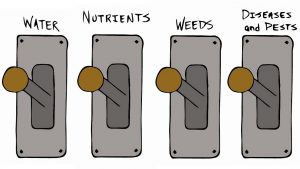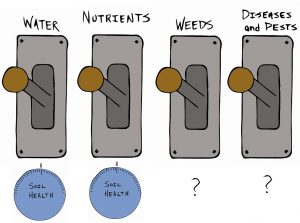Farming requires a lot of knowledge and skill. You have limited time and resources. It pays to know where your efforts will return the most benefits, your ROI. What is the ROI for investing in soil health? We want to give soil health due attention, but not more. Certainly, “soil health will save us from synthetic fertilizers and pesticides, climate change, food insecurity, hunger…” is too much. But what is enough?
First, we need to decide how to evaluate soil health’s ROI. Profit would be nice, but it is hard to measure in soil health terms. Yield is an important part of the profit equation and is much easier to estimate because we measure it in many research trials. What does research find on the benefits of soil health for yield?
Big Levers
First, we can identify the major factors on yield from yield gap analysis. In this analysis, researchers look at the factors that are keeping farmers from attaining what they call “crop yield potential.” which is the yield that can be attained without growth limitations from water, nutrients, pests, or diseases (Lobell et al. 2009, Mueller et al., 2012). And there we have our major factors:
- Water
- Nutrients
- Weeds
- Diseases and Pests
This is for a specific location, so the climate sets sunlight and temperature.
These are the four big levers you have to work with in terms of crop yield. If one of them is not managed, yield will suffer.

“… yield potential is the yield of an adapted crop variety or hybrid when grown under favorable conditions without growth limitations from water, nutrients, pests, or diseases” (Lobell et al., 2009)
Where is soil health?
Notice that soil health is not mentioned. Yield gap analysis assumes a minimal level of soil health, that there are no serious soil problems which could decrease yield, like pH, compaction, limited depth, etc. However, it also assumes that soil health is not a major factor. Water, nutrients, and pests, these are the big levers that you need to manage, but for each one, research suggests that soil health is a dial that can help you fine tune each factor, especially water and nutrients.

Soil Health and Nutrients
“Although many studies have described management-induced changes in biological soil health indicators, these indicators have only been loosely correlated with overall crop productivity,” Wade et al. 2020.
Of the major levers, soil health is most closely linked with nutrient cycling. A recent paper shows several important points. Using 29 sites across the Midwest, researchers evaluated the effects of various factors on corn yield (Wade et al. 2020). They found climate (temperature and water) is the largest factor affecting yield. Just behind climate is the nutrient factor, with the largest effects coming from nitrogen.
Soil health had no effect on the yield of unfertilized plots. This suggests 1) that soil health is not a major factor like temperature, water, or nitrogen, but that it enhances the effectiveness of nitrogen fertilizers: “improved soil biological health increases yields for a given fertilization rate.” Overall, the effect of soil health on corn yield was about 1/5th of that from nitrogen fertilizer.”
These nutrient-related effects of soil health are most likely from increased soil organic matter. A soil’s organic matter level is often used to indicate overall soil health and has strong links to many soil health benefits, such as aggregate stability and infiltration rates. However, for yield, research finds that soil organic matter’s effects on yield are limited to those from the nutrients made available through the decomposition of organic matter. Apart from these nutrient effects, soil organic matter, and therefore soil health, has little to no positive effect on yield (Oldfield et al. 2019, 2020, Wade et al. 2020, Hijbeek et al., 2017 and see Schjønning et al., 2018 and included references) or even a negative effect (Wood et al. 2016).
“… direct evidence linking greater SOM to increased yields is limited…” (Miner et al., 2020).
“Despite decades and actually centuries of research in SOM, it seems that the literature tends to just repeat the old dogma that SOM per se is a good thing for everything. Our results emphasize the need to distinguish between a N [nitrogen] and a non-N effect from SOM.” (Schjønning et al. 2018)
The link between soil health and more efficient use of nutrients has led some to believe that soil health can replace nutrients; it can’t. The best example I can think of for the limited importance of soil health for nutrient availability comes from organic farming. Organic farms often have better soil health – higher SOM, more mycorrhiza, etc. – than conventional farms but lower yields (Santoni et al., 2022; Seufert and Ramankutty, 2017). Soil health cannot overcome a lack of available nutrients in the system.
Although soil health, through soil organic matter, can supply only a portion of the nutrients needed for high yields, it helps with nutrient cycling, nutrient retention, and by allowing roots to fully explore the soil’s nutrient store. This fine tuning is where your soil health ROI is likely to be the largest in terms of crop yield. But there is another factor that you can fine-tune through soil health: water. I’ll cover that in the next post.
References
Hijbeek, R., M.K. van Ittersum, H.F.M. ten Berge, G. Gort, H. Spiegel, et al. 2017. Do organic inputs matter – a meta-analysis of additional yield effects for arable crops in Europe. Plant Soil 411(1): 293–303. doi: 10.1007/s11104-016-3031-x.
Lobell, D.B., K.G. Cassman, and C.B. Field. 2009. Crop Yield Gaps: Their Importance, Magnitudes, and Causes. Annual Review of Environment and Resources 34(1): 179–204. doi: 10.1146/annurev.environ.041008.093740.
Miner, G.L., J.A. Delgado, J.A. Ippolito, and C.E. Stewart. 2020. Soil health management practices and crop productivity. Agricultural & Environmental Letters 5(1): e20023. doi: 10.1002/ael2.20023.
Mueller, N.D., J.S. Gerber, M. Johnston, D.K. Ray, N. Ramankutty, et al. 2012. Closing yield gaps through nutrient and water management. Nature 490(7419): 254–257. doi: 10.1038/nature11420.
Oldfield, E.E., M.A. Bradford, and S.A. Wood. 2019. Global meta-analysis of the relationship between soil organic matter and crop yields. SOIL 5(1): 15–32. doi: https://doi.org/10.5194/soil-5-15-2019.
Oldfield, E.E., S.A. Wood, and M.A. Bradford. 2020. Direct evidence using a controlled greenhouse study for threshold effects of soil organic matter on crop growth. Ecological Applications n/a(n/a). doi: 10.1002/eap.2073.
Santoni, M., L. Verdi, S. Imran Pathan, M. Napoli, A. Dalla Marta, et al. 2022. Soil microbiome biomass, activity, composition and CO2 emissions in a long-term organic and conventional farming systems. Soil Use and Management n/a(n/a). doi: 10.1111/sum.12836.
Schjønning, P., J.L. Jensen, S. Bruun, L.S. Jensen, B.T. Christensen, et al. 2018. The role of soil organic matter for maintaining crop yields: Evidence for a renewed conceptual basis. Advances in Agronomy. Elsevier. p. 35–79
Seufert, V., and N. Ramankutty. 2017. Many shades of gray—The context-dependent performance of organic agriculture. Science Advances 3(3): e1602638. doi: 10.1126/sciadv.1602638.
Wade, J., S.W. Culman, J.A.R. Logan, H. Poffenbarger, M.S. Demyan, et al. 2020. Improved soil biological health increases corn grain yield in N fertilized systems across the Corn Belt. Scientific Reports 10(1): 1–9. doi: 10.1038/s41598-020-60987-3.
Comments
[…] my last post, we found that soil health was not a major factor for crop yield but is useful in fine-tuning crop […]
[…] It is the traditional practice used to avoid soilborne disease problems in annual cropping. As with nutrients and water, soil health is fine tuning for soilborne […]